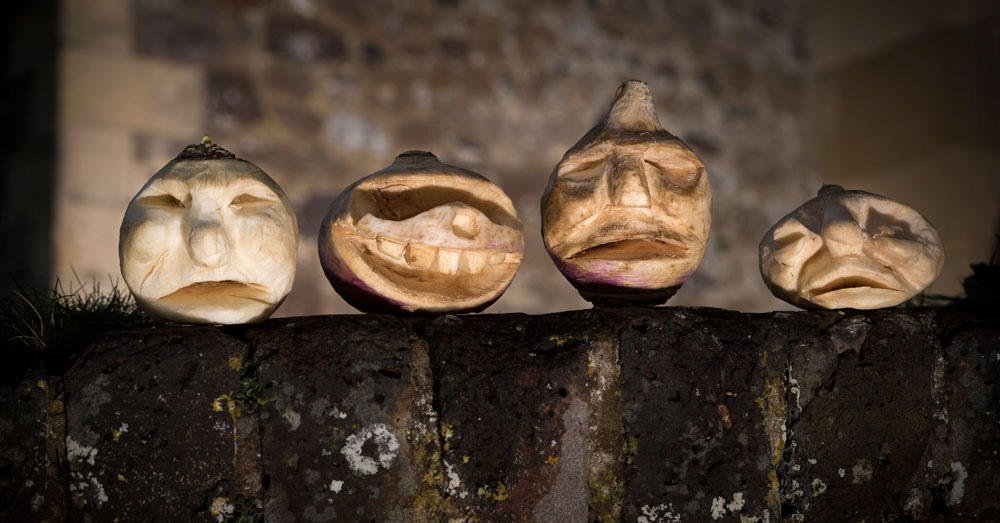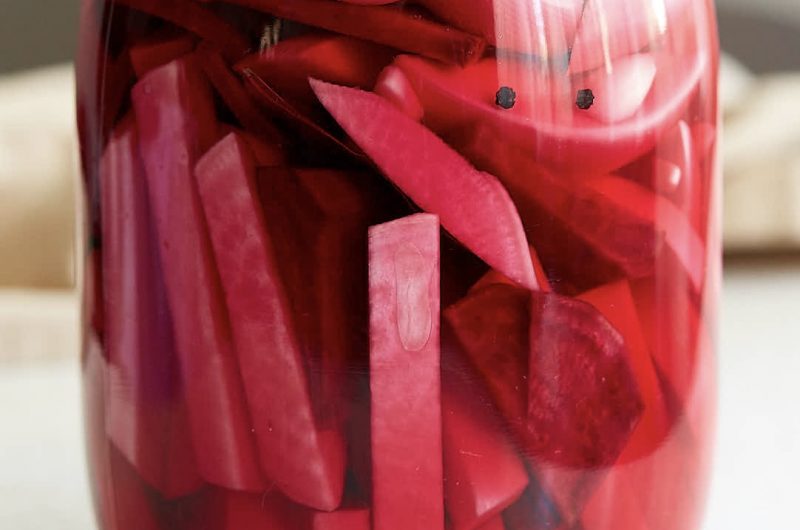In which we discover tricking the devil doesn’t always work out well, that sometimes in tales there are more turnips than women and that frankly you can pretty much pickle anything. We also learn that tricking people into sacks can be a learning experience and that precious has a lot of definitions.
In which we discover tricking the devil doesn’t always work out well, that sometimes in tales there are more turnips than women and that frankly you can pretty much pickle anything. We also learn that tricking people into sacks can be a learning experience and that precious has a lot of definitions.
We also examine the fascinating role of the turnip in history, medicine and folklore as well as its contribution to the culinary arts.
The stories in this episode are adapted from the following: The Turnip Princess from The Turnip Princess And Other Newly Discovered Fairy Tales – Franz Xaver von Schonwerth, The Turnip from Grimms’ Fairy Tales and The Smith And the Devil from a variety of sources.
The recipe in today’s episode is Middle Eastern Pickled Turnips
If you would like to find more information about any of the books or research in this episode you can find them in Further Reading.
You can also find out more at Hestia’s Kitchen which has all past episodes and the connected recipes on the blog. If you’d like to get in touch about the podcast you can find me on Twitter or Instagram at @FairyTalesFood.

Too Dark?
So how do you feel about these tales, I hope the Smith and the Devil wasn’t too dark for you? I also realise that the The Turnip is also pretty dark and that there is only one speaking role for a woman across all three tales! The darkness of the tales and the slightly scary ending of the Smith and the Devil feel perfect for the time of year. This is my favourite time of year and I’m enjoying the change in the season and the move towards a different way of eating for the colder weather.
I could actually taste that beef stew and fresh bread in the smithy as I told the tale and enjoyed a wonderful Beef Daube at the weekend which may have whetted my taste for it. As you can guess we will be concentrating on turnips later but in the meantime we should really look at these tales before I start asking everyone to start comparing cold weather recipes and we go off on a wonderful and delicious tangent. (Suggestions for cold weather recipes are always welcome by the way).
Tale as Old as Time
Let’s look at the Smith and the Devil first, as it is probably the oldest in its original variant anyway; according to research applying phylogenetic techniques to linguistics by folklorist Sara Graça da Silva and anthropologist Jamie Tehran. It is possibly one of the oldest European folk tales, and a variant was told first around 6000 years ago during the Bronze Age.
Apparently a version of the tale appears in The Pentamerone or Tale of Tales by Giambattista Basile but I may have missed it. It certainly appears in early Grimm collections of 1812 and 1815 before being removed in favour of Brother Lustig. A Russian version also appears in Tales and Legends from the Land of the Tsars from 1891. There is an Irish version which has a smith of a different name and appears in several versions in the Appalachians, possibly the most famous being the one by Richard Chase from 1948 known as Wicked John and the Devil.
Unfair Sterotyping?
There is a Gascon version and a Basque version that has inspired a horror film. Blacksmiths are often associated with evil and malevolence throughout European folklore with connections being made between the secrets and fires of the forge and the medieval version of hell. George Monbiot has written an excellent article on the topic, details of which are in further reading. Smiths are also often ambiguous characters in mythology, consider Wayland the Smith and Hephaestus.
I must admit here that I have, like many storytellers over time, combined several stories that have similar elements to build this story. I have used The Smith and the Devil and The Three Wishes, an Irish tale that has many themes in common and Stingy Jack, another Irish tale where a man tricks the devil.
Lost Stories
The Turnip Princess is a strange tale and might never have been recovered but for an accident. It was one of a collection of tales collected by the historian Franz Xaver von Schönwerth in Bavaria, In the 1850s, von Schönwerth traversed the forests, lowlands, and mountains of northern Bavaria to record fairy tales, gaining the admiration of even the Brothers Grimm but most of his work was lost – until 2012, when thirty boxes of manuscripts were uncovered in a German municipal archive.
The simplicity and directness of the tales suggests that they might be closer to the oral source of the tale than the Grimm variants. My only concern about this tale is what happens to the bear that turns into a man. It seems sad that we don’t know what happened to his ending.
A Jealous Obsession?
The Turnip is another Grimm tale which is frankly a little odd and also quite terrifying if you think about it for too long. That level of obsessive jealousy is one of the more frightening emotions which definitely hasn’t dated since these tales were first told sadly. I closed off the ending because frankly I felt the elder brother needed to at least have some comeuppance.
I was inspired by a wonderful storyteller, Taffy Thomas from his book the Storyteller’s Supper to add the turnip soup to make for hanging the poor student upside down for so long. You can imagine that the turnip farmer would still have lots lying around that didn’t quite fit into his new rich lifestyle. I’m sorry for making the student into a drinker but it fitted nicely with Grimm version which has him singing loudly as he approaches the younger brother in the forest.
From Worming Remedy to Sperm
I bet you didn’t know that turnip appeared in folklore and folk medicine did you? They don’t sound romantic enough really do they? Well the medicine they are used in tends not be that romantic either. Gerard’s Herball in 1597 suggests using the oil from the seed to kill worms in children. They are also used in a cure for coughs from Wiltshire in the form of lightly fermented juice of sliced turnip. This apparently also worked for whooping cough which you would hope as it sounds disgusting. Gerard believed that eating them increased the supply of breast milk. Others were firmly of the belief that they also increased sperm production when boiled and eaten with meat (type of meat not specified).
First Steal Your Turnip
The folklore isn’t plentiful but there is some: it has been recorded in the south of the US by African Americans that turnip seeds spread around the house were believed to have kept witches away. There is also some Welsh divination folklore about the vegetable. A girl must first steal a turnip (it can’t be bought or given) and peel it in one continuous strip and then bury the peel in the garden. The turnip must then be hung behind the door and she must go and sit beside the fire. The next man through the door will bear the same name as her future husband. Turnips were also carved and placed outside in Ireland, Scotland and Wales to protect against evil influences around Samhain or Halloween.
Not Your Average Root Vegetable
So, lets look at the turnip as a vegetable. Its been around a long time, much longer than you think. They are thought to originate in northern Europe around 2000 BCE. They are not actually a root vegetable. The bit that people think is a root is actually the swollen base of the stem and is not the only edible part of the plant. The young leaves know as turnip greens are very popular when the commercial crop is thinned out. People have been trying to differentiate between the different types of turnip plants since Roman times.
Essentially there is the white turnip known as brassica rapa, the swede/rutabaga is known as brassica napus rapifera and finally rape, grown for its oil bearing seeds is brassica napus. Apparently botanists still aren’t in complete agreement about whether this classification is correct. The Latin names explain how the name neeps came about in Scotland although confusingly they actually mean swede rather than turnips. Rape is also common as a reference in older medieval cookbooks. The french name for turnips is navet which is also from the Latin root words.
Then Pickle Your Turnip or Catch a Duck
Turnips appear in medieval cook books including a pickle in the Forme of Cury 1390 (see below) and appears fairly regularly after that. It is cooked and served with Duck in The Good Housewife’s Jewell by Thomas Dawson in 1596 and in a Spanish style dish known as Olio in The English Housewife by Gervase Markham 1631. It appears in English style pickles and chutneys but it appears that the English speaking world is the only one to serve the older, bigger turnips boiled and mashed. The French much preferring to eat them young and glazed as part of elegant casseroles.
COMPOST. C. Take rote of parsel. pasternak of rasenns. scrape hem waisthe hem clene. take rapes & caboches ypared and icorne. take an erthen panne with clene water & set it on the fire. cast all þise þerinne. whan þey buth boiled cast þerto peeres & parboile hem wel. take þise thynges up & lat it kele on a fair cloth, do þerto salt whan it is colde in a vessel take vineger & powdour & safroun & do þerto. & lat alle þise thinges lye þerin al nyzt oþer al day, take wyne greke and hony clarified togider lumbarde mustard & raisouns corance al hool. & grynde powdour of canelpowdour douce. & aneys hole. & fenell seed. take alle þise thynges & cast togyder in a pot of erthe. and take þerof whan þou wilt & serue forth.
Forme of Cury
(England, 1390)
International Turnip
The turnip spread through Asia to northern China and from there to Japan. It is served roasted in China or dried in strips and salted or preserved in soy sauce whereas in Japan it is used more for pickling and for decoration. It is also used for pickling in Korea. The Middle East is also known to eat pickled turnips in large quantities, but these are not spiced and beetroot is often added to the vinegar to give them their beautiful fluorescent pink colour.
It is to these today that I turn for our recipe. I love these and they bring extra flavour and joyful colour to the beigest of meals.Try them with falafel and houmous or with any type of shawarma.
Pickled Turnips
8
servings30
minutes10
minutesIngredients
350g turnips biggish if you can get them
½ small beetroot
275ml water
100ml white vinegar
30g salt
1 tsp mustard seeds
1 tsp sugar
2 garlic cloves
1 bay leaf
Directions
- Top and tail the turnips and beetroot. Remove the skins. Cut into large batons. Set aside.
- Add the rest of the ingredients to a saucepan. Bring to the boil, stirring occasionally.
- Meanwhile, clean a jar with hot water and dry it in the oven. Fill with turnips and beetroot, top with the hot pickling liquor. Put the lid on tightly and allow to cool. These will keep in the fridge for a month but if you can wait at least 24 hours before trying them, they will benefit
Notes
- You can adjust this for size of jar but just make sure the vegetables are covered by the pickling liquid
Further Reading
http://helewyse.medievalcookery.com/libro.html#XXI
Forme of Cury, 1390
The English Housewife, Gervase Markham 1631
The Good Housewife’s Jewell, Thomas Dawson 1596
WINSTANLEY L, Rose HJ. Welsh folklore items, III. Folk-lore. 1928;39:171–178
Dictionary of Plant Lore – D.C. Watts
https://www.foodtimeline.org/
https://aggie-horticulture.tamu.edu/plantanswers/publications/vegetabletravelers/turnip.htmlIt’s Halloween: The Jack-o’-Lantern Story: Uncut and Uncensored – Lesley Bannatyne
https://www.monbiot.com/1994/01/01/smith-and-the-devil/
https://unmaskedhistory.com/2019/10/29/folklife-the-ghostly-legend-of-wicked-john-and-the-devil/
The Turnip Princess And Other Newly Discovered Fairy Tales – Franz Xaver von Schonwerth, Maria Tatar (Edited by) Erika Eichenseer (Edited by)
The Storyteller’s Supper – Taffy Thomas


